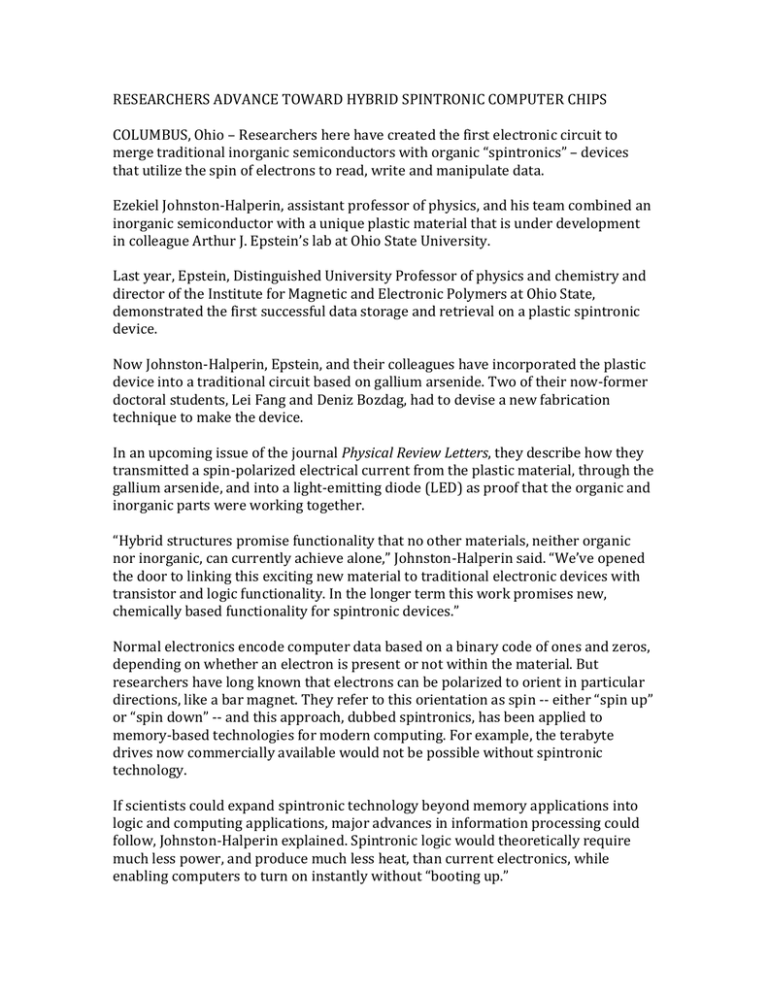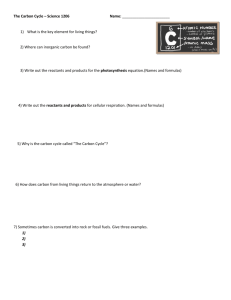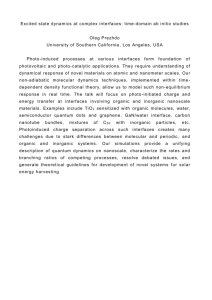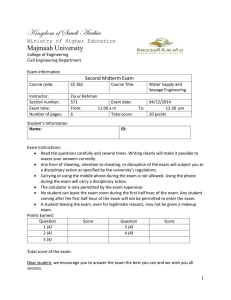RESEARCHERS ADVANCE TOWARD HYBRID SPINTRONIC COMPUTER CHIPS
advertisement

RESEARCHERS ADVANCE TOWARD HYBRID SPINTRONIC COMPUTER CHIPS COLUMBUS, Ohio – Researchers here have created the first electronic circuit to merge traditional inorganic semiconductors with organic “spintronics” – devices that utilize the spin of electrons to read, write and manipulate data. Ezekiel Johnston-Halperin, assistant professor of physics, and his team combined an inorganic semiconductor with a unique plastic material that is under development in colleague Arthur J. Epstein’s lab at Ohio State University. Last year, Epstein, Distinguished University Professor of physics and chemistry and director of the Institute for Magnetic and Electronic Polymers at Ohio State, demonstrated the first successful data storage and retrieval on a plastic spintronic device. Now Johnston-Halperin, Epstein, and their colleagues have incorporated the plastic device into a traditional circuit based on gallium arsenide. Two of their now-former doctoral students, Lei Fang and Deniz Bozdag, had to devise a new fabrication technique to make the device. In an upcoming issue of the journal Physical Review Letters, they describe how they transmitted a spin-polarized electrical current from the plastic material, through the gallium arsenide, and into a light-emitting diode (LED) as proof that the organic and inorganic parts were working together. “Hybrid structures promise functionality that no other materials, neither organic nor inorganic, can currently achieve alone,” Johnston-Halperin said. “We’ve opened the door to linking this exciting new material to traditional electronic devices with transistor and logic functionality. In the longer term this work promises new, chemically based functionality for spintronic devices.” Normal electronics encode computer data based on a binary code of ones and zeros, depending on whether an electron is present or not within the material. But researchers have long known that electrons can be polarized to orient in particular directions, like a bar magnet. They refer to this orientation as spin -- either “spin up” or “spin down” -- and this approach, dubbed spintronics, has been applied to memory-based technologies for modern computing. For example, the terabyte drives now commercially available would not be possible without spintronic technology. If scientists could expand spintronic technology beyond memory applications into logic and computing applications, major advances in information processing could follow, Johnston-Halperin explained. Spintronic logic would theoretically require much less power, and produce much less heat, than current electronics, while enabling computers to turn on instantly without “booting up.” Hybrid and organic devices further promise computers that are lighter and more flexible, much as organic LEDs are replacing inorganic LEDs in the production of flexible displays. A spintronic semiconductor must be magnetic, so that the spin of electrons can be flipped for data storage and manipulation. Few typical semiconductors – that is, inorganic semiconductors – are magnetic. Of those that are, all require extreme cold, with operating temperatures below −150 degrees Fahrenheit or −100 degrees Celsius. That’s colder than the coldest outdoor temperature ever recorded in Antarctica. “In order to build a practical spintronic device, you need a material that is both semiconducting and magnetic at room temperature. To my knowledge, Art's organic materials are the only ones that do that,” Johnston-Halperin said. The organic magnetic semiconductors were developed by Epstein and his long-standing collaborator Joel S. Miller of the University of Utah. The biggest barrier that the researchers faced was device fabrication. Traditional inorganic devices are made at high temperatures with harsh solvents and acids that organics can’t tolerate. Fang and Bozdag solved this problem by building the inorganic part in a traditional cleanroom, and then adding an organic layer in Epstein’s customized organics lab – a complex process that required a redesign of the circuitry in both parts. “You could ask, why didn’t we go with all organics, then?” Johnston-Halperin said. “Well, the reality is that industry already knows how to make devices out of inorganic materials. That expertise and equipment is already in place. If we can just get organic and inorganic materials to work together, then we can take advantage of that existing infrastructure to move spintronics forward right away.” He added that much work will need to be done before manufacturers can massproduce hybrid spintronics. But as a demonstration of fundamental science, this first hybrid circuit lays the foundation for technologies to come. For the demonstration, the researchers used the organic magnet, which they made from a polymer called vanadium tetracyanoethylene, to polarize the spins in an electrical current. This electrical current then passed through the gallium arsenide layer, and into an LED. To confirm that the electrons were still polarized when they reached the LED, the researchers measured the spectrum and polarization of light shining from the LED. The light was indeed polarized, indicating the initial polarization of the incoming electrons. The fact that they were able to measure the electrons’ polarization with the LED also suggests that other researchers can use this same technique to test spin in other organic systems. Coauthors on the paper included former doctoral student Chia-Yi Chen and former postdoctoral researcher Patrick Truitt. This research was funded by the National Science Foundation’s Materials Research Science and Engineering Centers program, Ohio State’s Institute for Materials Research, and the Department of Energy. # Contacts: Ezekiel Johnston-Halperin, (614) 247-4074; Johnston-halperi.1@osu.edu Arthur J. Epstein, (614) 292-1133; Epstein.2@osu.edu Written by Pam Frost Gorder, (614) 292-9475; Gorder.1@osu.edu






